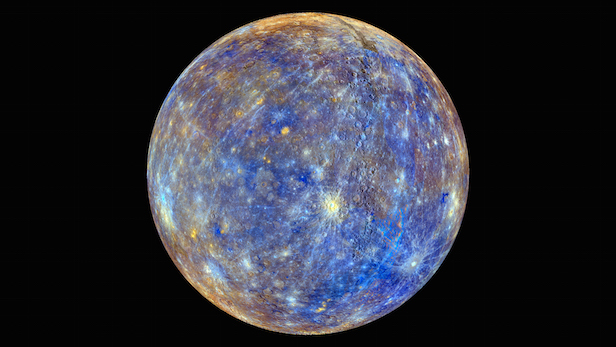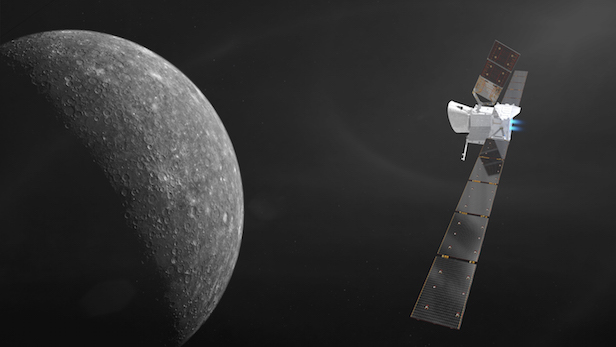Astronomers discover what’s powering Mercury’s magnetic tail
Models and simulations have provided strong evidence that Mercury’s plasmoids could be accelerating electrons from the Sun

MESSENGER gathered much information about Mercury, including colour base map images. Image credit: NASA/JHUAPL/Carnegie
A new theoretical model can now explain the unusual nature of Mercury’s magnetic tail. The results from the 2009 Mercury Surface, Space Environment, Geochemistry and Ranging (MESSENGER) mission showed scientists that Mercury has a perplexingly strong magnetic tail, and now scientists have come up with a possible explanation.
The global magnetic fields which encompass different planets depend upon the churning of liquid metal under the planet’s surface. The shape, size, angle and strength of a magnetic field varies greatly with each planet, but they are all-important for protecting planets from solar particles.
Solar winds spread far and wide throughout the Solar System and bombard each planet with highly energetic particles, creating a magnetic substorm in the process. This is the driving force behind aurorae, which create a magnificent spectacle on Earth. Magnetic tails or magnetotails form when intense radiation pressure from solar winds ‘pushes’ on the planet’s magnetic fields. The tails arise from the nightside of a planet. The confusing aspect of this is that Mercury’s magnetic tail is bigger and more rapid than that observed on Earth.
For Mercury to have a magnetic field that is 100-times weaker than Earth’s, and then to have MESSENGER go and observe Mercury’s magnetic tail – the Hermean magnetotail – to be stronger than Earth’s caused quite the dilemma for scientists. “We wanted to find out why the satellite found energetic particles,” says Xiaowei Zhou of the Max Planck Institute for Solar System Research, Göttingen, Germany.

BepiColombo is a joint endeavour between ESA and the Japan Aerospace Exploration Agency, JAXA. Image credit: ESA/ATG medialab/NASA/JPL
A likely scenario that is manipulating such a situation could well be magnetic connection. Magnetic reconnection occurs when the arrangement of magnetic field lines changes, releasing kinetic and thermal energy. Unfortunately this particular scenario is not very well understood, but in this study Chinese and German astronomers investigated the mechanics in the context of the upheaval present in the Hermean magnetotail.
Extensive Magnetohydrodynamic simulations, along with test particle calculations, showed that plasmoids – magnetic structures that encompass plasma – could be generated during magnetic reconnection. These plasmoids could accelerate charged particles, and this would support the data seen by MESSENGER.
A mean-turbuelence model was also made in order to describe the turbulence of subgrid-scale physical processes. In this model the acceleration process was customised to mimic the conditions in the Hermean magnetotail. These simulations were also able to show that the turbulent nature of plasmoid reconnection could be responsible for speeding up the electrons. “We also showed that turbulence enhances reconnection by increasing the reconnection rate,” explains Zhou.
This team’s work has led to the predicted upper limit for the turbulent plasmoid reconnection and the corresponding electron acceleration. The BepiColombo mission, which is due to launch in October 2018, will prove these theories further. The BepiColombo satellites will be built to withhold the harsh solar radiation, and will also be placed into an orbit around Mercury in 2025 that will last one Earth year.
“Previous satellites could not test the high energies from electrons, and one aim of this mission is to measure the energetic particles from the Hermean magnetotail with new detector technology,” says Zhou. The only hope to confirm or deny these theories is more comprehensive data, which requires finer technologies.
 Keep up to date with the latest news in All About Space – available every month for just £4.99. Get 5 issues of All About Space for just £5 with our latest offer!
Keep up to date with the latest news in All About Space – available every month for just £4.99. Get 5 issues of All About Space for just £5 with our latest offer!




